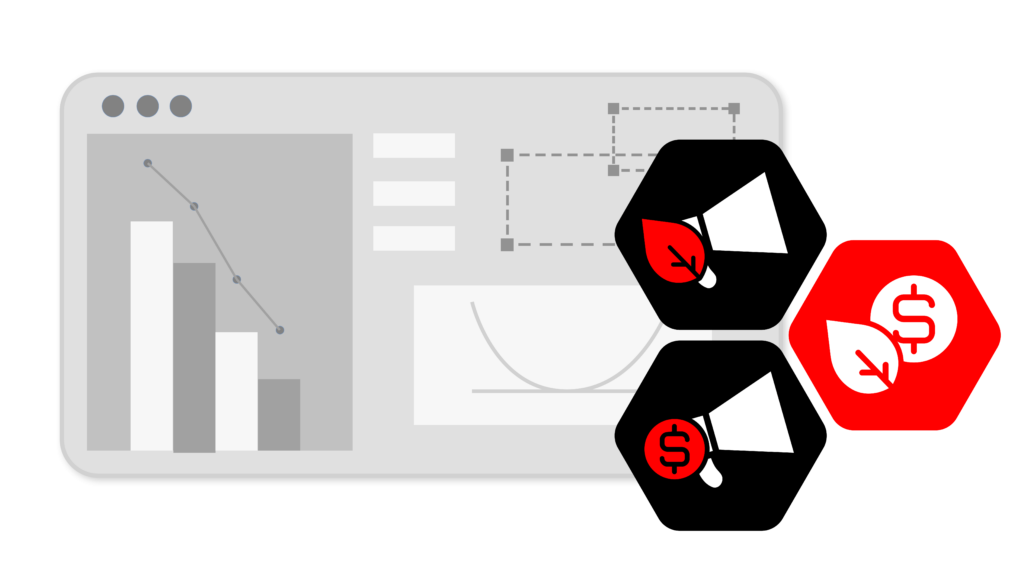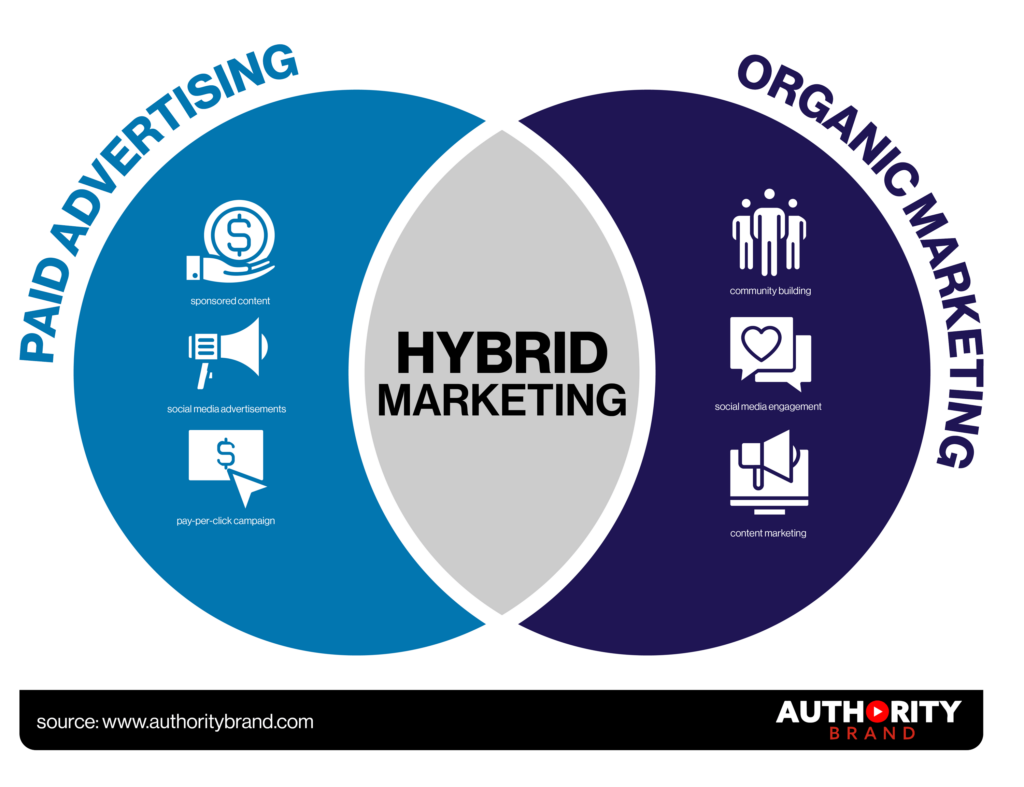Lead Generation
Hybrid Marketing:
Balancing Paid and Organic Strategies for Maximum Impact

In today’s digital marketing landscape, businesses must be savvy and adaptable to stay ahead of the curve. To achieve the best results, the most innovative companies are integrating paid and organic strategies using a revolutionary approach known as hybrid marketing. With its ability to maximize the benefits of each strategy, hybrid marketing is the secret weapon in the arsenal of top-performing businesses.
So, what exactly is hybrid marketing? It’s a comprehensive approach that combines the best elements of organic marketing (social media engagement, SEO, and content marketing) with paid marketing (direct-cost promotions and advertisements). By marrying the two, businesses can effectively negotiate the complexity of the digital environment while successfully engaging with their target audience.
The term “hybrid marketing” refers to a comprehensive strategy that combines the best elements of both paid and organic marketing. This approach is vital because it enables companies to connect the advantages of both strategies, negotiate the complexity of the digital environment, and successfully engage with their audience. By using hybrid marketing, businesses can increase conversions, maintain growth, and stay competitive in a constantly changing digital landscape.
The importance of hybrid marketing cannot be overstated. This approach allows companies to increase conversions, maintain steady growth, and stay competitive in the ever-changing digital landscape. So, if you are looking to stay ahead of the game, it’s time to embrace the power of hybrid marketing.
Welcome to Authority Brand – where we’re all about helping you turn potential customers into lifelong customers using our direct response principles and the revolutionary ANSWER framework. But wait, there’s more – we’ve got a secret weapon up our sleeves, and it’s called social media! Our team of social media experts develops personalized strategies to meet your unique needs and goals. We don’t just aim to grab your audience’s attention; we strive to captivate them and turn them into loyal customers. Together, we can elevate your social media game and create a buzz around your brand! So why wait? Join us today, and let’s make magic happen.
1. Understanding Hybrid Marketing
What is Hybrid Marketing

In today’s ever-changing digital landscape, hybrid marketing is a comprehensive approach that combines the power of paid marketing strategies with organic marketing tactics to create a masterful plan that maximizes impact and reach. By striking the perfect balance between paid and organic marketing techniques, hybrid marketing is like a mystical potion that creates a coherent and successful plan.
Hybrid marketing is the ultimate fusion of organic approaches’ legitimacy and long-term viability with paid strategies’ quick and focused reach. It emphasizes the art of balancing produced and organic methods to achieve greater visibility, engagement, and conversion. This approach is agile and adaptable, allowing businesses to adjust to algorithm changes and variations in customer behavior in the ever-changing digital environment.
Paid advertising campaigns include sponsored content, social media ads, and pay-per-click (PPC) campaigns. They offer rapid outcomes, accurate targeting, and instant visibility. On the other hand, organic marketing emphasizes non-paid tactics such as community building, social media engagement, and content marketing.
2. The Power of Paid Marketing
Advantages of Paid Marketing Strategies
Looking for a way to get your brand in front of the right people? Look no further than pay-per-click (PPC) campaigns! PPC allows targeted reach based on keywords and demographics, with payment only required upon ad clicks. Get instant visibility with the top search engine results page ads.
But that’s not all! Social media ads are another great way to reach a specific audience. Platforms like Facebook, Instagram, and Linked allow targeted advertising based on demographics, interests, and behaviors. And with instant visibility, you’ll get your message in front of the right people.
And if you are looking for even more credibility and visibility, sponsored content is the way to go. You can reach a larger audience through reliable sources by collaborating with publications or influencers. Instantly, this can enhance brand recognition and credibility.

Measuring ROI in Paid Marketing
In today’s world, measuring the return on investment (ROI) in paid marketing is crucial for businesses to optimize their strategies, allocate budgets effectively, and maximize their return on investment. To achieve this, specialized tools are used to track campaign performance and analyze various metrics.
One such tool is Google Analytics, which acts as a watchful eye, monitoring user activity, website traffic, and conversions to provide insights into the effectiveness of your sponsored campaigns. Google Analytics enables you to track essential metrics such as bounce rate, time spent on site, and conversion rate, providing valuable insights into your campaign’s performance.
Another tool that can help you evaluate the effectiveness of your paid campaigns is Facebook Ads Manager. This tool provides complete analytics on ad performance, such as impressions, clicks, conversions, and cost per result. Facebook Ads Manager allows you to monitor your ad performance in real-time and make necessary adjustments.
LinkedIn Campaign Manager is another tool that can help you evaluate the effectiveness of your paid campaigns. This tool offers comprehensive data on audience interaction, campaign lead generation, and ad performance. With LinkedIn Campaign Manager, you can easily keep track of important metrics like click-through rate (CTR), conversion rate, cost per acquisition (CPA), and return on ad spend (ROAS). This data can provide valuable insights into the effectiveness of your paid campaigns.
The click-through rate (CTR) refers to the proportion of users who click on an advertisement after viewing it. A higher CTR indicates better ad engagement. The conversion rate is the percentage of users who click on an advertisement and then take a desired action, such as filling out a form or purchasing. CPA determines how much it costs to get a new customer through sponsored campaigns, which helps determine if a campaign is effective. ROAS calculates the revenue generated per dollar spent on advertising.
3. The Role of Organic Marketing
Benefits of Organic Marketing Efforts
Developing brand loyalty and trust over time involves various strategies. Search engine optimization (SEO) improves website visibility and organic search rankings for users seeking similar products or information.
Another strategy is content marketing, which establishes expertise and fosters trust with the audience by offering valuable and relevant content through blogs, videos, and resources.
Social media engagement is also crucial in building a community, exchanging meaningful content, and interacting with the audience organically. This helps to develop trust and loyalty over time.

Sustainability of Organic Growth

Organic Audience Development can be challenging due to various obstacles. Firstly, it is time-intensive and requires persistent work to develop organic reach and credibility. Unlike paid tactics, which yield immediate results, organic efforts require patience. Secondly, social media and search engine algorithms are constantly changing, affecting organic visibility and reach. Thirdly, standing out in a sea of content is difficult due to intense competition for organic visibility.
Despite these challenges, building an organic audience has several benefits. Firstly, it helps establish long-term credibility, trust, and loyalty with the audience, resulting in more enduring and devoted client relationships. Secondly, organic approaches frequently involve a lower upfront cost when compared to paid tactics, making them cost-effective in the long run. Lastly, organic strategies respond more flexibly to algorithm changes and customer behavior, making them adaptable once established.
4. Crafting a Hybrid Marketing Approach
Combining Paid and Organic Strategies

There are a few things to keep in mind when it comes to combining organic and paid strategies. First, it’s essential to maintain consistent messaging across all channels to strengthen your brand identity. Additionally, combining paid and organic efforts data can provide a more comprehensive understanding of your audience’s behavior and preferences.
Another critical factor is an integrated content strategy that benefits your audience at multiple touchpoints and enhances sponsored advertisements and natural outreach initiatives. To create a seamless customer journey, it’s also essential to use organic channels to increase the reach of paid campaigns and vice versa.
The “Test and Learn” approach involves experimenting with various paid and organic strategy combinations to determine which works best for your target audience. By modifying your approach accordingly, you can optimize your marketing plan and achieve better results.
Conclusion: Mastering the Synergy of Paid and Organic Marketing in the Digital Era
A well-balanced hybrid marketing strategy combines the advantages of paid and organic marketing techniques to create a comprehensive and thriving marketing ecosystem. Entrepreneurs are encouraged to be innovative and flexible. By exploring the combination of sponsored and organic strategies, brands can discover unique ways to connect with their target audience, drive conversions, and achieve long-term success in the competitive industry. As the digital landscape evolves, businesses looking to thrive and expand will find adapting and pivoting with a hybrid marketing strategy increasingly crucial.
Transform Your Ad Campaigns
Discover the fastest and easiest way to effortlessly triple your ad profits using Trust Scaling.
